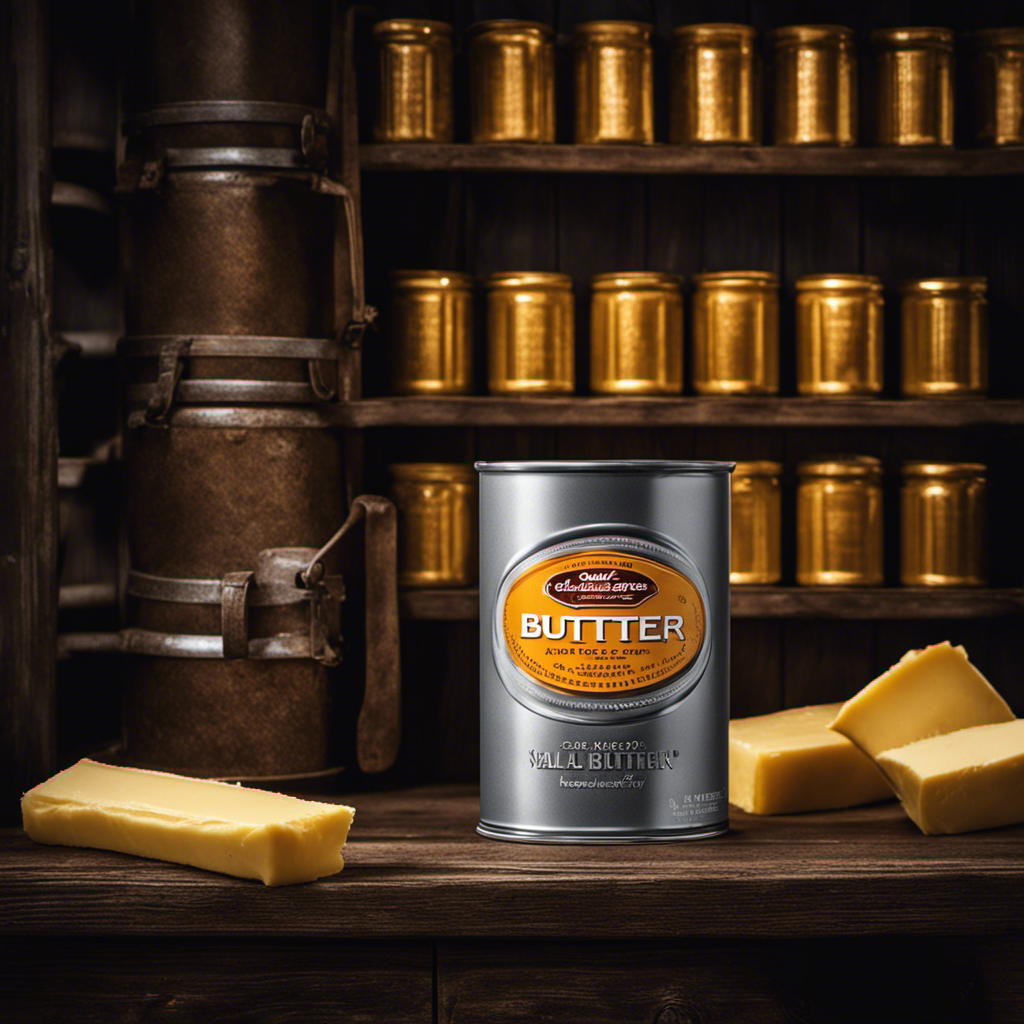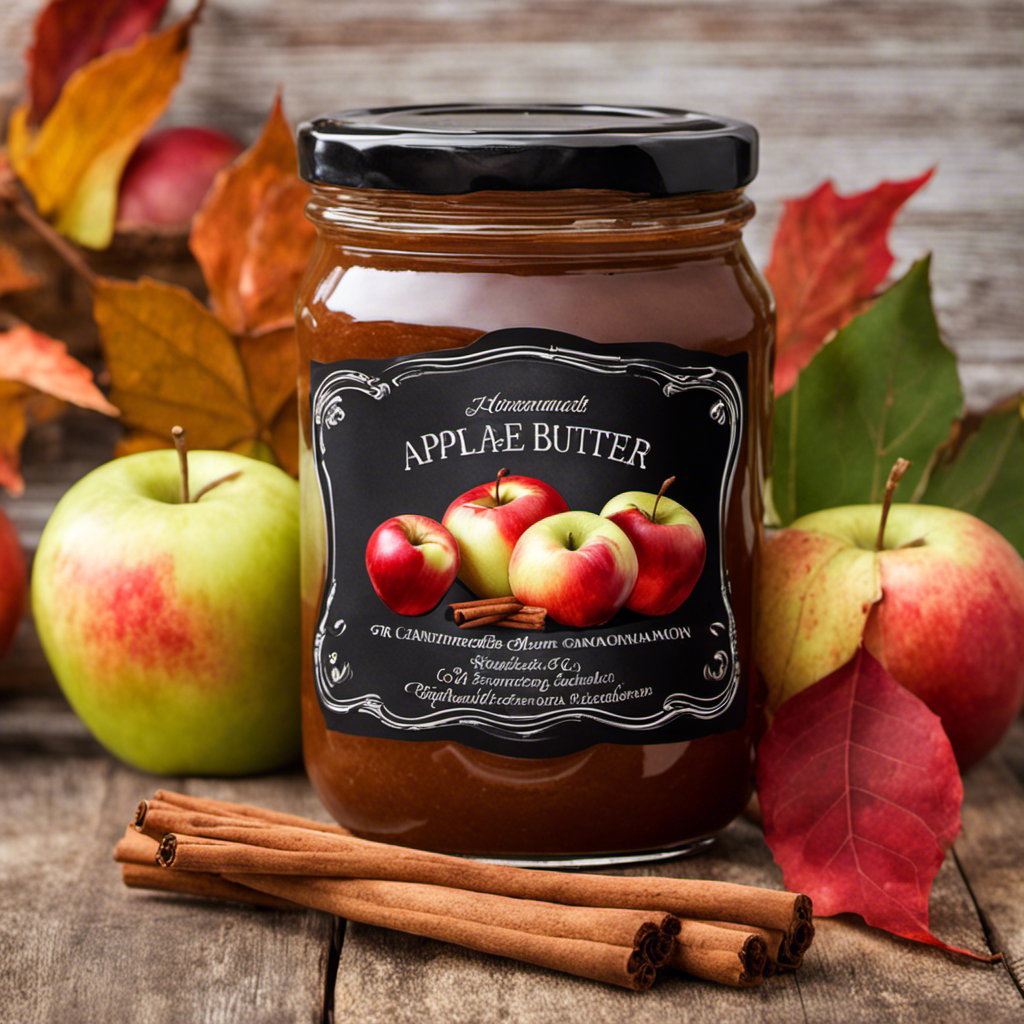Have you ever thought about the shelf life of canned butter? I’m here to give you all the necessary information.
In this article, we will delve into the shelf life of canned butter, the factors that affect its longevity, and the proper storage tips to ensure it stays fresh for as long as possible.
Additionally, we will explore signs of spoiled canned butter, ways to extend its lifespan, and even how to safely consume expired canned butter.
Let’s get started!
Key Takeaways
- Shelf life of canned butter varies depending on brand and storage conditions.
- Proper storage techniques, such as keeping it in a cool and dry place, can extend the shelf life of canned butter.
- Signs of spoiled canned butter include rancid odor, mold or discoloration on the surface, and unusual texture.
- Canned butter can have a longer shelf life (up to 2 years) compared to other butter storage methods, but it may have a slightly different texture and taste.
Shelf Life of Canned Butter
You’ll be interested to know that the shelf life of canned butter can vary depending on the brand and storage conditions. Factors affecting the freshness of canned butter include the quality of the butter used, the processing methods, and the packaging.
Canned butter typically has a best before date, which indicates the time period during which the butter is expected to retain its quality. It is important to check this date before consuming the butter to ensure its freshness.
Additionally, proper storage conditions, such as keeping the cans in a cool and dry place, away from direct sunlight, can help extend the shelf life of canned butter. It is recommended to consume canned butter within the specified best before date for the best taste and quality.
Factors Affecting the Longevity of Canned Butter
Factors affecting how long canned butter can stay fresh include temperature, humidity, and storage conditions. These factors play a crucial role in determining the longevity of canned butter.
Temperature is one of the most important factors to consider. It is recommended to store canned butter in a cool and dry place, away from direct sunlight and heat sources. High temperatures can cause the butter to melt or spoil more quickly.
Humidity is another factor to keep in mind. Excessive moisture can lead to the growth of mold or bacteria, which can spoil the butter.
Lastly, proper storage techniques are essential for preserving canned butter. It is recommended to store it in airtight containers or cans and to avoid exposure to air or moisture.
Following these guidelines can help extend the shelf life of canned butter.
Proper Storage Tips for Canned Butter
One of the key tips for properly storing canned butter is to keep it in a cool and dry place. This is essential for ensuring its long term storage and maintaining its quality.
When it comes to storing canned butter, here are some important tips to consider:
- Place the canned butter in a temperature-controlled environment, ideally between 50-70 degrees Fahrenheit.
- Ensure that the storage area is free from direct sunlight, as exposure to heat and light can cause the butter to spoil.
- Store the canned butter in airtight containers to prevent moisture and air from entering, which can lead to spoilage.
- Avoid storing canned butter near strong-smelling foods as it can absorb odors.
- Regularly check the expiration date and rotate the stock to ensure freshness.
By following these proper storage techniques, you can maximize the shelf life of your canned butter and enjoy its delicious taste for an extended period.
The canning process helps preserve the butter’s quality and flavor, but it’s crucial to store it correctly to maintain its longevity.
Signs of Spoiled Canned Butter
When it comes to determining whether canned butter has spoiled, there are several key indicators to look out for.
The first is the odor or smell – if the butter emits a rancid or sour scent, it is likely no longer safe to consume.
Additionally, mold or discoloration on the surface of the butter can also be a clear sign of spoilage.
Lastly, pay attention to the texture or consistency of the butter; if it appears grainy, watery, or separated, it is best to discard it to avoid any potential health risks.
Odor or Smell
The odor of canned butter can indicate whether it has gone bad or not. Paying attention to the smell of canned butter is one of the key freshness indicators. Here are some important points to consider:
-
Rancid smell: If the canned butter smells rancid or sour, it is likely spoiled and should not be consumed. This odor can indicate the presence of harmful bacteria or oxidation of the fats in the butter.
-
Off-putting aroma: A strong, off-putting smell, different from the usual buttery scent, can also be a sign of spoilage. Trust your nose and if something seems off, it’s better to be safe than sorry.
Mold or Discoloration
To determine if your butter has gone bad, check for any mold or unusual discoloration. Mold prevention is crucial in ensuring the safety and quality of your butter. Mold can grow on butter when it is exposed to moisture or when it is stored in warm and humid conditions.
If you notice any fuzzy patches or greenish-blue spots on your butter, it is a clear indication of mold growth. Additionally, keep an eye out for any color change in your butter. While butter typically has a pale yellow color, if it starts to appear darker or develops a grayish hue, it may be a sign of spoilage.
Proper storage in a cool and dry place can help prevent mold growth and maintain the freshness of your butter.
Texture or Consistency?
Butter that has gone bad may have a gritty or slimy texture. It is important to pay attention to the texture of butter as it can indicate its freshness and quality. When butter becomes gritty, it may be a sign that it has been exposed to air for too long or that it has been improperly stored. On the other hand, a slimy texture can be a result of bacterial growth or spoilage.
When butter develops an off-putting texture, it can also affect its flavor. Rancid butter may have a sour or unpleasant taste, which can ruin the overall taste of a dish. It is crucial to discard any butter that has a strange texture or flavor to avoid any foodborne illnesses.
In terms of cooking applications, butter with a gritty or slimy texture may not incorporate well into recipes and can alter the texture of baked goods. It is best to use fresh, high-quality butter for optimal results in cooking and baking.
Extending the Lifespan of Canned Butter
When it comes to extending the lifespan of canned butter, there are several key points to consider.
First and foremost, proper storage techniques play a crucial role in preserving its freshness.
Understanding the shelf life factors and implementing effective preservation methods are equally important in ensuring the longevity of canned butter.
Proper Storage Techniques
Make sure you’re keeping your canned butter in a cool and dry place to ensure proper storage and longevity. Proper storage techniques are essential for maintaining the quality and safety of canned butter. Here are some best practices for safe handling and storage:
-
Store in a cool location: Keep your canned butter away from direct sunlight and heat sources to prevent it from melting or spoiling.
-
Maintain a dry environment: Moisture can lead to the growth of mold and bacteria. Store your canned butter in a dry place, such as a pantry or cupboard.
-
Avoid fluctuating temperatures: Extreme temperature changes can negatively affect the quality of canned butter. Keep it in a place where the temperature remains consistent.
-
Check for signs of spoilage: Before consuming canned butter, always inspect for any signs of spoilage, such as an off smell, unusual texture, or discoloration.
Shelf Life Factors
To extend the shelf life of your canned butter, it’s important to consider factors such as temperature, exposure to light, and the quality of the container. Proper storage conditions can significantly impact the longevity of your canned butter.
Temperature is a crucial factor in preserving the quality of canned butter. It is best to store it in a cool and dry place, away from direct sunlight or heat sources. Exposure to light can cause the butter to oxidize and spoil faster. Therefore, it is advisable to store it in a dark location or use opaque containers.
The quality of the container also plays a vital role in maintaining the shelf life of canned butter. Ensure that the container is airtight and made from materials that do not react with the butter. Metal cans or glass jars with tight-fitting lids are ideal for long-term storage.
By considering these factors and providing the proper storage conditions, you can maximize the shelf life of your canned butter and enjoy its creamy goodness for an extended period.
| Shelf Life Factors | Emotional Response |
|---|---|
| Temperature | Fresh and Secure |
| Exposure to Light | Protection |
| Quality of Container | Longevity |
| Airtight | Reliability |
| Maximum Shelf Life | Peace of Mind |
Preservation Methods
Preservation methods, such as proper storage and container selection, are essential for extending the shelf life of canned butter. Here are some key techniques to ensure the longevity of your canned butter:
-
Storage Temperature:
-
Keep canned butter in a cool and dry place, ideally below 70 degrees Fahrenheit.
-
Avoid exposure to direct sunlight or heat sources, as it can cause the butter to spoil quickly.
-
Container Selection:
-
Opt for high-quality, airtight containers that provide a strong seal to prevent air and moisture from entering.
-
Glass jars with secure lids or metal cans with tight-fitting lids are excellent choices for preserving canned butter.
By implementing these preservation techniques, you can significantly increase the lifespan of your canned butter.
However, if you’re looking for alternative storage methods, freezing can be a viable option. Just make sure to use freezer-safe containers and label them properly to keep track of expiration dates.
Safe Consumption of Expired Canned Butter
Did you know that consuming expired canned butter can pose health risks?
It is important to ensure the safe consumption of canned butter, especially when it has reached its expiration date. When canned butter expires, its quality and safety may be compromised.
Consuming expired canned butter can lead to food poisoning, as the butter may contain harmful bacteria or toxins. It is crucial to check the expiration date on the can and discard any expired butter.
Additionally, it is recommended to store canned butter in a cool and dry place to extend its shelf life. By practicing safe consumption and properly storing canned butter, you can minimize the risk of foodborne illnesses and enjoy its delicious taste.
Comparing Canned Butter to Other Butter Storage Methods
When it comes to storing butter, canned butter is just one option among many. Let’s compare canned butter to other butter storage methods and weigh the pros and cons.
Pros of Canned Butter:
- Long Shelf Life: Canned butter can last for up to 2 years, making it a great option for long-term storage.
- Convenience: Canned butter is ready to use and requires no refrigeration, making it perfect for camping or emergency situations.
Cons of Canned Butter:
- Limited Availability: Canned butter can be harder to find compared to other storage methods.
- Texture and Taste: Some people find that canned butter has a slightly different texture and taste compared to freshly-churned or store-bought butter.
Other Butter Storage Methods:
- Refrigeration: Storing butter in the refrigerator can extend its shelf life for a few weeks.
- Freezing: Butter can be frozen for up to a year without significantly affecting its quality.
Frequently Asked Questions
Can Canned Butter Be Frozen to Extend Its Shelf Life?
Yes, you can freeze canned butter to extend its shelf life. Freezing canned butter has the benefit of preserving its freshness and preventing spoilage. It’s a great way to ensure that your butter lasts longer.
Are There Any Health Risks Associated With Consuming Expired Canned Butter?
Consuming expired canned butter may pose health risks. It is important to check the expiration date and avoid consuming it past that point. Expired butter may lose its nutritional value and can potentially cause foodborne illnesses.
How Does the Shelf Life of Canned Butter Compare to Other Types of Canned Goods?
Comparing the shelf life of canned butter to other canned goods, canned butter has a distinct advantage for long term storage. Unlike canned vegetables, canned butter can last for years without spoiling, making it a reliable option for emergency food supplies.
Can the Taste and Quality of Canned Butter Be Affected by Storage Conditions?
Storage conditions can greatly impact the taste and quality of canned butter. If expired, there may be health risks associated with consuming it. It’s important to properly store and check the expiration date to ensure safety.
Are There Any Specific Recommendations for Using Canned Butter in Recipes or Baking?
When it comes to using canned butter in recipes or baking, there are a few specific recommendations I can offer. For example, it’s important to soften the butter before using it for better results.
Conclusion
In conclusion, after conducting extensive research on the shelf life of canned butter, it’s clear that this storage method can significantly extend the butter’s lifespan.
Factors such as proper storage and regular inspection play a crucial role in maintaining the quality of canned butter. By following the recommended guidelines, consumers can safely consume expired canned butter without compromising their health.
It’s also important to note that canned butter outperforms other storage methods, making it a reliable option for long-term butter preservation.









